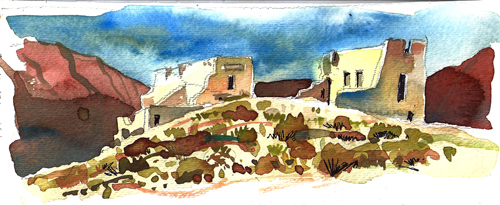Fort Churchill a link to bloody, unsettled era

Ghostly adobe ruins mark the perimeter of the parade ground at Fort Churchill, Nevada’s first military installation, between Carson City and Fallon. Preserved as a state historical park, Fort Churchill acquaints visitors with a turbulent time just before Nevada became a state.
Unique among Nevada parks, Fort Churchill’s expanded acreage along the lovely Carson River links with nearby Lake Lahontan State Recreation Area, protecting a vital recreation corridor.
By the shortest route, the park is 352 miles from Las Vegas. Take U.S. Highway 95 north to the junction with U.S. Highway 50 in Fallon. Stay on U.S. 50 heading west toward Carson City. At Silver Springs, turn south on U.S. 95A and drive 8 miles to the park entrance road. Expect to pay a $5 entrance fee if you are a Nevada resident or $7 for nonresidents.
Stop first at the visitor center housed in a barracks restored by Civilian Conservation Corps workers in the 1930s. Serving as park headquarters, the sturdy building contains exhibits and artifacts detailing Fort Churchill’s history, natural features and native people of the region. The park encompasses the remains of the Civil War-era fort, nearby Buckland Station and the adjacent 3,200-acre Carson River Ranches. Fort Churchill includes picnic areas, two campgrounds, group areas and miles of trails developed with assistance from volunteers.
Shaded by strands of cottonwoods, the popular picnic area sits close to the Carson River. Picnickers enjoy a serene setting with flocks of birds busy overhead. The area’s recreational appeal draws birders, canoeists, kayakers, hikers, mountain bikers, horsemen and photographers.
The main campground, with 20 sites, is between the picnic area and the visitor center. A more primitive 11-unit campground downriver appeals to horsemen with its corrals, water troughs and room to maneuver horse trailers. There are no hookups in either campground. Campsites are available on a first-come basis. Nevada residents pay $15 for overnight use of campsites, while nonresidents pay $17.
A handsome two-story structure, Buckland Station stands along U.S. 95A about half a mile south of the park entrance road where the highway crosses the river. Constructed in 1870 by pioneer rancher Samuel Buckland, the restored hotel figured prominently in the area’s history, its past intertwined with that of the nearby fort. The property became part of the park in 1997. Visitors pay a $1 museum fee to tour the refurbished interior.
The enterprising Buckland arrived in 1859 to ranch and establish a roadhouse on the immigrant trail following the river. By 1860, Buckland had replaced the original tent with a ranch house that served as a trading post, tavern and hotel. He added wagon repair and blacksmithing services, pastured livestock, built an irrigation system to water crops and charged a toll to use the bridge he constructed over the river.
In May 1860, trouble with the native Paiutes threatened the entire area. White men working at an overland route station abducted and abused two young Paiute women. In retaliation, the Paiutes killed the white men and burned the station. They took the rescued girls back to their camp at Pyramid Lake. Thus began the disastrous Pyramid Lake War.
Carson City’s Major William Ormsby assembled 105 militia volunteers at Buckland Station. He marched them into defeat at an ambush where he and 75 others died. Territorial leaders demanded help from the federal government, which ordered army Captain Joseph Stewart to build a military post midway between the Pyramid Lake and Walker Lake Paiute camps. Construction on Fort Churchill began in July 1860. The war ended when Stewart’s forces defeated the Paiutes.
Nevada became the 36th state on Oct. 31, 1864.
The fort served as a key supply depot for the Union Army during the Civil War but was abandoned in 1869.
When the army auctioned off salvageable material at the fort, Samuel Buckland bought everything for $750, leaving only the adobe walls standing. Some of the materials went into the construction of his new hotel close to the river.
Margo Bartlett Pesek’s column appears on Sundays.












